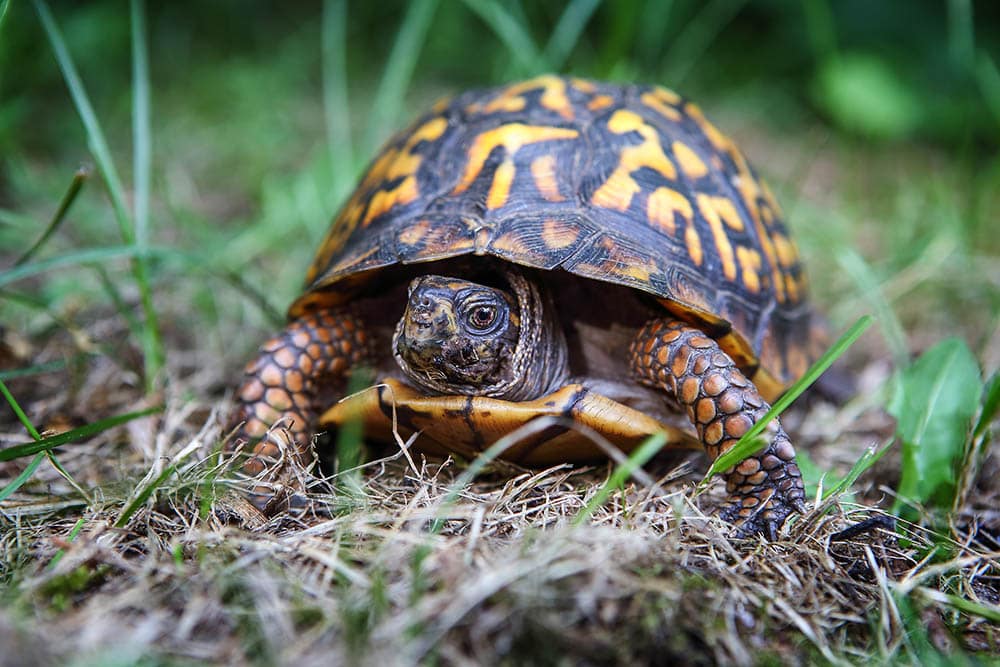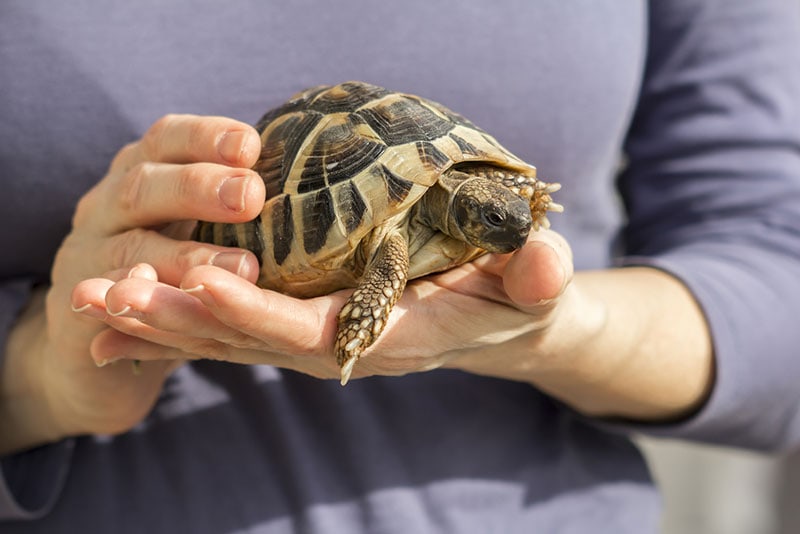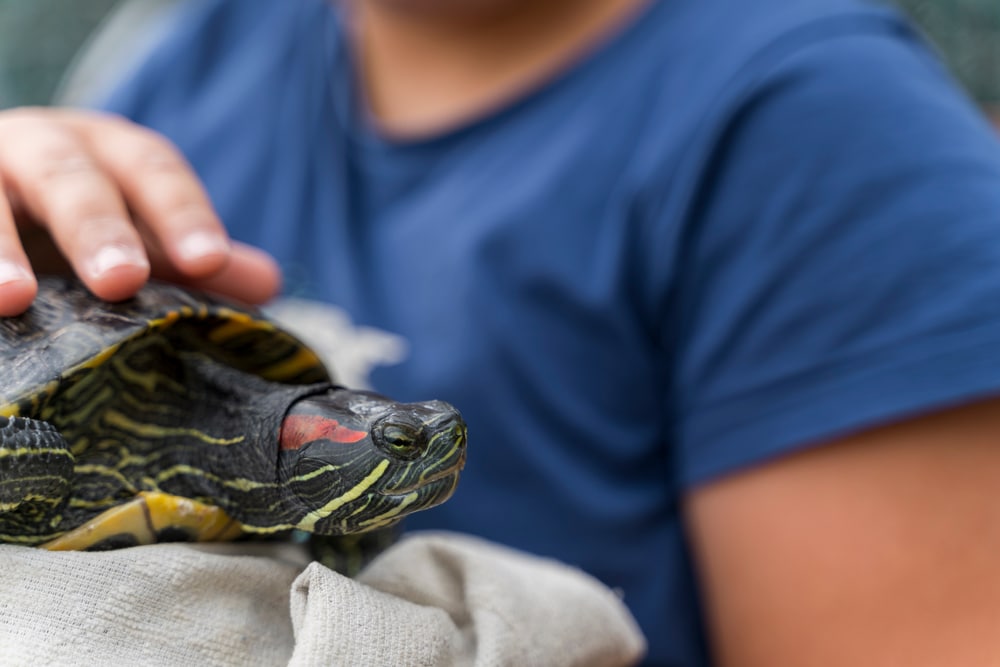
Click to Skip Ahead
Were you one of the kids that grew up dreaming of owning a turtle? These slow-moving creatures aren’t only fascinating but they are also cute as can be. If, now that you’re an adult, you’re considering bringing a turtle into your home as a pet, you’re going to have questions. One of the most important is, are turtles social animals? How do they do with companions? While you may prefer to have multiple turtles living and thriving together, they unfortunately aren’t very social creatures. From what has been observed, turtles prefer to be solitary animals but that doesn’t mean they won’t recognize you as their caregiver.
Let’s learn more about these amazing creatures so you can make the turtle you bring into your home happy and keep it healthy.
Are Turtles Social Animals?
With turtles preferring a life of solitude, you may ask why you see turtles together in the wild. While you may think this is a sign of them socializing, that’s not actually the case. Turtles are very independent creatures in the wild. This doesn’t change when they become your pet. Yes, they depend on you to supply them with their needs, but they aren’t feeling lonely or pining away for a tank mate. At least, it doesn’t appear that they are.
In the wild, turtles can be quite territorial. Some have even been seen to bully other turtles. When turtles are being kept as pets, pairing them, especially if they are both males, can be difficult. Aggression and fighting do happen. Turtles have even been known to kill one another, in the wild and captivity, when these types of fights break out and no one is there to intervene.

When Are Turtles Social Animals?
If you’re viewing turtles in the wild, it’s not uncommon to find them basking together or even stacked on top of one another. This makes potential turtle owners ask, isn’t that social behavior? No, not necessarily. Turtles don’t need interactions with others, but if they need to share space in the wild, they will. Let’s take a look at times when you may see turtles exhibiting social actions in the wild.
Basking
Turtles need to bask to raise their body temperature. If there is a great spot for basking, several turtles are likely to make use of it. During these basking times, you’ll not see a lot of social interaction going on. It’s simply basking, not a friendly gathering. Scratching, biting, and fighting can even happen if space is limited in the great local basking area.
Stacking
What’s stacking you may ask? This is when turtles climb on top of one another in hopes of getting warmed up. You would think this would be seen as a social reaction, but it isn’t. Again, this is turtles gathering to help meet their needs.

Mating
Mating is when turtles are at their social best. When it’s time to mate, turtles need to act to attract the opposite sex. This can happen in a one-on-one situation or group gatherings. There are several ways turtles may attract a mate. Some species use blinking, others use their claws, and some even resort to spitting. Whatever form of courting the particular turtle species uses, mating can be considered social interaction. There are also lots of fights and signs of aggression when turtles are competing for a mate. While seeing these encounters isn’t pleasant, they are also ways of socializing during mating season.
Nesting
Certain breeds of turtles gather when it comes time for nesting. This is when the females lay their eggs after mating season. While not all turtle breeds do this, these actions can be considered social for those that do.

Hatching
One of the unique things about turtles is that they aren’t very social once they are hatched, but while in the egg, they are. Now, don’t get this misconstrued. Yes, baby turtles communicate while in the egg, but it isn’t to form friendly bonds. The baby turtles inside the eggs are determining with one another when the right time is to emerge from their shells. Doing this in large numbers gives the babies a better chance of survival.
Eating
In most cases, turtles aren’t big on sharing their food. However, that doesn’t mean it never happens. When food is abundant, you may find more than one turtle eating together. They aren’t gathered to make friends. They are together in hopes of getting a good meal. If there isn’t enough food to go around, the socializing is halted and aggression takes over.
Do Pet Turtles Socialize with Humans?
It’s natural for people to want any pet inside their home to love them in return. Turtles, unfortunately, aren’t big on this type of behavior. Now, does that mean they won’t interact with you or show affection? Of course it doesn’t. Turtles can recognize their owners thanks to sight and smell. The more you’re around and the more you feed them, they are going to associate you with something good. When this association takes place, you’ll notice that your turtle pays attention when you enter a room, and even acts interested in what you’re doing. Your pet may even show a bit of affection by nibbling your fingers or coming to you when you’re interacting with it. These types of behaviors show that your turtle has become comfortable with you and doesn’t mind you being around.

Should I Get My Turtle a Companion?
That is totally up to you, however, it isn’t necessary. As we said, turtles are solitary animals. If more than one turtle is a must for you, give it a shot. Your turtles may get along great. There are also a couple of things you can do to help out in this area.
Final Thoughts
Turtles are one of the most interesting creatures out there. In the wild, turtles are fun to observe. In the home, however, there’s so much more to enjoy. Turtles may not be the most social animals out there and are known for not always getting along with companions, but that doesn’t change that they are amazing pets. If you have, or plan on getting, a pet turtle you won’t need to worry about finding the perfect tank companion for it. Your turtle will do just fine on its own. Besides, it has you to provide it with everything it needs.
- Related Read: Are Turtles Good Luck? Symbolism Explained
Featured Image Credit: Shalstock, Shutterstock







